On Sunday morning, August 12, a group of us woke up early to go visit the Dome of the Rock. This is the area above the Temple Mount that is one of the most sacred spaces to Islam. We were above what was The Temple Mount. This is the site of Solomon’s great temple, which the Romans destroyed in 70 AD. More than 10,000 people were killed here during that destruction and many more tens of thousands in the city during that siege.
![]()
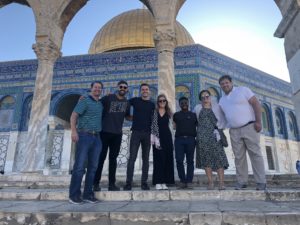 The Temple was built here by Solomon because this is believed to be the site where Abraham was prepared to sacrifice his son Isaac. When God saw Abraham’s willingness to obey him, no matter the cost, he told him that his descendants would be as numerous as the stars in the sky.
The Temple was built here by Solomon because this is believed to be the site where Abraham was prepared to sacrifice his son Isaac. When God saw Abraham’s willingness to obey him, no matter the cost, he told him that his descendants would be as numerous as the stars in the sky.
Today, the three major religions of the world – Judaism, Christianity, and Islam – all are faiths extending back to Abraham. God’s promise has been fulfilled. Abraham’s descendants are perhaps more numerous than he could have imagined.![]()
Hundreds of years after the Romans destroyed the Temple, Islam was formed – in the 7th Century AD – and they eventually claimed this sacred spot as the place of a great mosque, one of their greatest – the Dome of the Rock. It has stood here since it was first built in 691 AD, when it became the tallest and most recognizable symbol in Jerusalem, as it still is today.

While non-Muslims like us are not be permitted inside the mosque, we are able to be on the grounds surrounding the mosque, during certain hours of the day. In order to access this area, we had to stand in a security line that was a bridge that goes “over” the Western Wall. This is how complicated this area is, with its history, and the peace settlement today. To gain access to the area of the Western Wall (the holiest site in all of Judaism), you have to stand in one security line. But to gain access to the area above the Western Wall, where the Dome of the Rock is located, you stand in a separate security line. These are different security lines controlled by different nations.
As we approached the security gate, which opened at 7:30am, we were passing through an area that is controlled not by the Palestinians, but rather by the Kingdom of Jordan. Some years ago, the Israelis reached a peace agreement with the Muslim world, and they have good relations with Jordan, who they agreed would be the right nation to secure this area. As we stood there on Sunday morning, there were hundreds of Jewish people below us praying at the Western Wall.
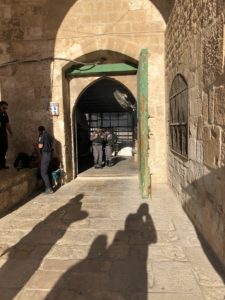
When we walked onto the grounds above the Western Wall, now in an area protected by the Kingdom of Jordan, the architecture suddenly changed to the Islamic architecture that is so familiar in much of the Muslim world and which I have seen in places like southern Spain. The mosque – the Dome of the Rock – is absolutely beautiful. There were few people there at this hour, only a handful more than the half dozen or so in our group. I was even able to get some great photos of the Dome with no one in the photos. The doors to the mosque are guarded by members of their community, to make sure only Muslims come in.
We strolled the grounds around the Dome for about a half hour or so, just taking in the peaceful setting at this hour. Around us, we could see almost all of Jerusalem and the surrounding countryside. Given all the conflict over this sacred spot, considering all the death and destruction that has happened right here, it was hard to imagine because of the peace we felt on this particular blue sky Sunday morning.
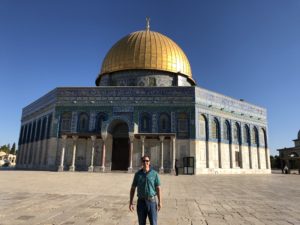
After our visit, we went back to our hotel to meet the rest of our group for breakfast, and then we boarded our bus for a short drive over to get a tour of the Israeli security fence – by the man who built it.
But before we did that, we stopped at the new U.S. Embassy in Jerusalem. For years, our embassy has been in Tel Aviv, but this psat year President Donald Trump moved it to Jerusalem, the city that Israel recognizes as its capital.
As our tour guide Yoav told us, he said all the Israeli people are incredibly grateful to the United States for doing this, however he says they don’t get what is the big deal or why it took us so long. Are there any other countries where we don’t put our embassy in the recognized capital city? It makes you think why Israel is always singled out. Perhaps this is just part of the long history of the battle for Jerusalem that has divided so many in the past. I can tell you I am really proud that our country now recognizes Jerusalem as the capital of Israel and that we moved our embassy here.
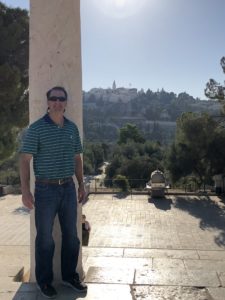
However, there was no one working around the embassy (except for a few security guards) on this Sunday morning, but we went up and took photos at the spot commemorating its opening just three months before our visit on this day
From there, we boarded back on the bus and met with Dany Tirza near the border between Jerusalem and Bethlehem. He was in the military for 30 years, a colonel in the Israel Defense Forces (IDF). He took part in the negotiations with the Palestinians between 1993-2007. And yes, he is the man who was asked to design and build the security fence between Israel and its enemies.
He told us about the demographic changes that have taken place in Bethlehem, an area we were looking across to, and the area we were just in the day before. For hundreds of years, Christians were the majority of the population in Bethlehem, the birthplace of Christ. In 1995, Israel ceded control to the Palestinians and the majority of Christians left. Today, Christians are less than 12% of the population there and the numbers are rapidly declining. And there are absolutely no Jews, who are not allowed there.
 The security fence is 451 miles long. It separates Israel from “Zone A” of the West Bank – an area we toured the previous day. 95% of this secured border is just a fence, while about 5% of it is a wall.
The security fence is 451 miles long. It separates Israel from “Zone A” of the West Bank – an area we toured the previous day. 95% of this secured border is just a fence, while about 5% of it is a wall.
During our tour of the security fence (from the Israeli side) on this morning, we went down to one of the highest parts of the wall, which seemed about 30 feet high. The entire area has a high level of technology. If someone on either side merely touches the fence, it sends an electronic signal to a computer that is monitored by the Israeli Defense Force. Within minutes they can have an IDF officer to the location that the fence was touched. And in many places they have security cameras that can monitor the area as well. Even if someone from the Palestinian side were to jump the fence, they won’t get far. In an area we toured, there is about a half mile distance between the security fence and the population of Israel.
 To get this perspective, one area where we stood on our tour, was right next to an apartment building that was hit with many shots that were fired during the height of the Second Intifada just a decade or so ago. There is now about a half mile barrier of land between them and the Israeli security fence. Thousands of Israelis were killed in terrorist attacks in the 1990s and early 2000s. In 2002 alone, 450 Israeli citizens were killed by Palestinian terrorists.
To get this perspective, one area where we stood on our tour, was right next to an apartment building that was hit with many shots that were fired during the height of the Second Intifada just a decade or so ago. There is now about a half mile barrier of land between them and the Israeli security fence. Thousands of Israelis were killed in terrorist attacks in the 1990s and early 2000s. In 2002 alone, 450 Israeli citizens were killed by Palestinian terrorists.
Tirza told us that Israel was faced with no choice but to build this security fence – and the Israeli government delegated responsibility of this to the military, for both strategic and political reasons. Tirza was the man put in charge of overseeing this effort. And here he was today with us, giving us a first-hand account of why and how the fence was built.
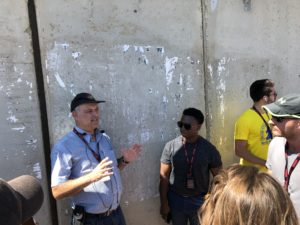 Tirza has given similar tours to then Secretary of State Hillary Clinton and then Senator Barack Obama in the mid-2000s. I asked him if he had ever talked to President Trump about building a wall (something we are debating in the United States) and he said he had not. But he told me after Trump was elected, Forbes featured him in an article titled, “What Trump Can Learn From The Man Who Built Israel’s Border Walls.” I pulled it up and read it on the bus ride after our tour.
Tirza has given similar tours to then Secretary of State Hillary Clinton and then Senator Barack Obama in the mid-2000s. I asked him if he had ever talked to President Trump about building a wall (something we are debating in the United States) and he said he had not. But he told me after Trump was elected, Forbes featured him in an article titled, “What Trump Can Learn From The Man Who Built Israel’s Border Walls.” I pulled it up and read it on the bus ride after our tour.
Before we departed from Tirza, after getting a full tour for a couple hours along the border walls, I personally thanked him for all he has done to save the lives of thousands of Israelis and Palestinians, and for keeping visitors like us safe today. Israel is a much safer and more secure place because of this wall. No doubt about it. I was once again really grateful that the Israel Collective provided us with this opportunity to encounter a man who made such history, and such a profound impact on the geopolitical situation in this region. A true humanitarian.
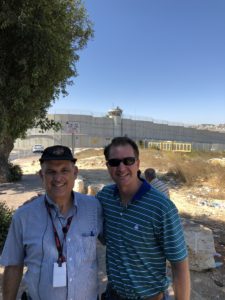
Tirza told us he finds it unfortunate there has to be a wall separating people. He has been to places like Berlin, where a wall was built by the Soviet Union to keep people in East Germany, away from the freedom of the West. He rejoiced – like the rest of the world – when that wall came down. Of course, the security fence (and wall) separating peoples here has openings and thousands of people cross in and out of there every day, through security check points. So it is not a wall that compares to the totalitarian Berlin Wall in any true comparison. It is simply a very controlled border.
However, Dany told us he hopes he lives to see the day that this security fence and wall will come down here in Israel. And he added that he hopes to be there to remove the first parts of the wall. He was very sincere about this, almost emotional.
After we left Dany Tirza, we went to the Old City of Jerusalem, had lunch, and then had a very quick tour, led by our tour guide Yoav, through the Church of the Holy Sepulchre and the Via Dolorosa, the path which Jesus carried his cross through Jerusalem before he was led to his crucifixion, which took place on the site that the Church of the Holy Sepulchre sits today.
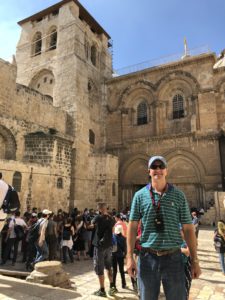
As I wrote about in a previous blog post, a group of us visited the Church of the Holy Sepulchure early in the morning on Friday. It was a much different place on a busy Sunday afternoon. It was almost chaotic with all the tourists in there, compared to the tranquility we experienced between 6:30am and 8am on Friday, when we attended mass. I was thankful Yoav had recommended we go there on our own if we wanted a more religious experience. In the afternoons, the tourists are almost trampling over each other and the lines are long. Yoav simply took us through quickly, pointed out some of the major sites within the Sepulchre, and led us back through the streets of the Old City.
From there, we had a few hours of free time. I was exhausted after the early wake up and went back to the hotel for a short nap. We all then met back up for dinner, which we had in a restaurant full of umbrellas hovering over us in an outdoor courtyard. A few of us then went to the rooftop of our hotel, enjoyed some wine and cigars, and closed out our final night in Jerusalem. Four nights here in a city full of thousands of years of history, much of it filled with conflict. But today, thanks to agreements between nations, security checkpoints, security fences, and walls, the people here live in peace with security that is at such levels that I felt as safe as anywhere I could possibly be in the world today.
And thanks for the opportunity to reflect at such holy sites as the Western Wall, the Dome of the Rock, and the Church of the Holy Sepulchre, I left Jerusalem filled with such peace and refreshment. In a word: fulfillment. My life dream of visiting the world’s holiest city had been met. Before leaving, I had already decided: I want to come back.
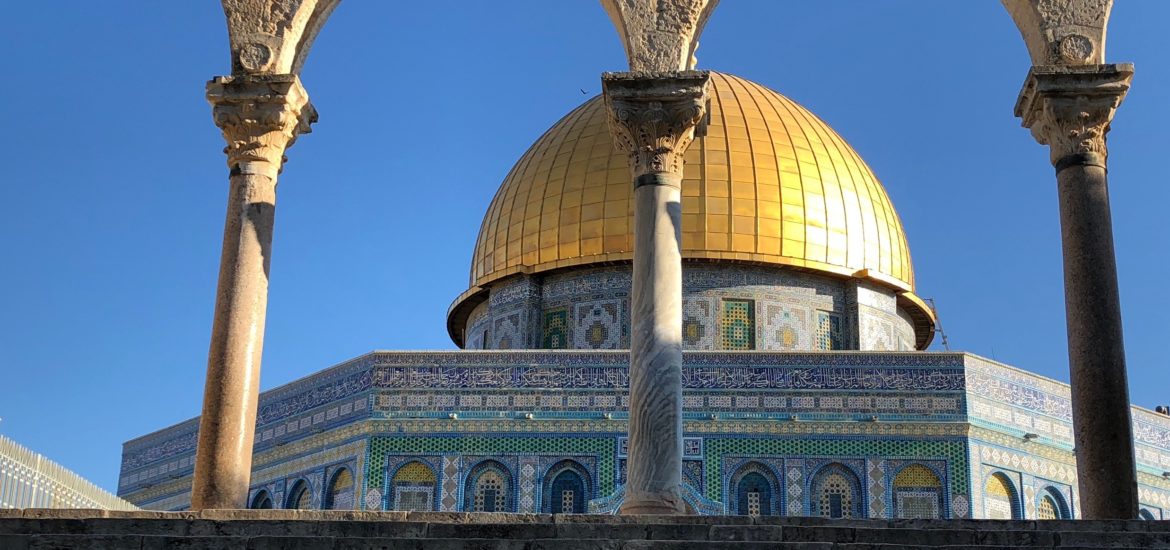
So happy that you were able to have this incredible experience! Thanks for sharing your experience.